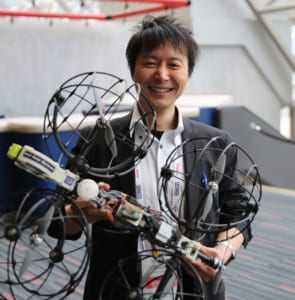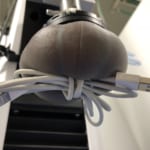[Interview with Speaker at the 9th Annual Meeting]Associate Professor Kenjiro Tadakuma, Tohoku University, "Innovative Robot Development Incorporating the Concept of Softness into the Mechanism" (Japanese)
2020.01.15[Interview with Associate Professor Kenjiro Tadakuma, Tohoku University, a Speaker at the 9th Main Conference of the Association of Hyperdifferent Fields (from Research Support Vol. 16)].
Dr. Kenjiro Tadakuma is scheduled to speak at "Yawarakatta de Engineering ga Yawarakatta (Engineering Changes with Softness)" to be held in Session Room A at 17:00 on the first day of the 9th Annual Meeting of the Association of Hyperdifferent Fields (March 6 and 7, 2020).
Innovative robot development incorporating the concept of softness into the mechanism

By incorporating soft matter into the field of robotics, one researcher is trying to expand the framework of the conventional idea that robots = metal. He is Kenjiro Tadakuma of Tohoku University. In addition to his own area of expertise in robot mechanics, he is actively utilizing cutting-edge materials and equipment to open up a new field of study.
Conflicting high rigidity and flexibility
Often, by incorporating knowledge and technology from other fields, researchers are able to find clues to research that has been slow to progress. In the field of robotics, it is common to use metal and plastic to make skeletons, housings, and drive systems, but the field of soft robotics, which incorporates soft matter, is emerging. Soft robotics, however, is emerging as a field that incorporates soft matter. It is becoming possible to achieve things that are difficult to achieve with hard materials alone, such as flexible movement and stable grasping of objects. Mr. Tadakuma is presenting new possibilities in this field of soft robotics one after another from his unique perspective. When I was in graduate school, I was conducting research on drive mechanisms for planetary exploration robots, which had been a dream of mine since childhood. In the course of his research, he came to focus on the torus mechanism, and has now begun to apply this mechanism not only to moving objects but also to robot hands.
Capturing the Wind of the Times and Making Breakthroughs
Two factors had a major impact on Tadakuma's research. One was the advent of easily processable rubber materials. Mr. Tadakuma told us of the surprising origin of this rubber material, which was actually used for special makeup mainly in the Hollywood movie industry. It evolved and became easier to use in the pursuit of reality, which coincidentally contributed to the research of soft robotics. Another was the advent of inexpensive and easy-to-handle 3D printers. The combination of these two factors made it possible for people to quickly create the parts they envisioned themselves, and this accelerated research at a rapid pace. For example, in the jamming membrane gripper mechanism, a powder encased in a rubber membrane was used for the part of the robot hand that comes in contact with the object to be grasped. This makes it possible to grasp even complex shapes and fragile objects by making the membrane harden (jamming transition phenomenon) by removing air between the powder and the object after it has been blended into the shape of the object by pressing it against it.
Learn from biology and push the boundaries of ideas.
By actively utilizing soft matter in omni-directional moving and driving mechanisms, Mr. Tadakuma has created new robot hands and moving objects. For example, in a robot hand that implements a torus mechanism, the rubber material covering the surface of the torus structure is slowly rotated at a constant speed in the order of outside, inside, and outside. This allowed the rubber material to adhere closely to the object as it wriggled into the tube, and also to grasp the object by pulling it in through the rotational motion of the hand tip. Thanks to the flexible rubber bag-like structure, it can grip objects of various shapes (Figure 1). In addition, when this is used as an undercarriage for a mobile object, it can enter a narrow environment such as rubble because it can generate driving force when it is grounded at any point outside the torus structure. Tadakuma is also challenging a new mechanism that goes one step further from the so-called tube-like shape of the torus mechanism. The inspiration came from a mysterious creature called a caterpillar. When I think of new structures and movements, I learn a lot from observing living things," says Tadakuma, who got the idea for the branching structure from a caterpillar. Chordates are a general name for animals belonging to the phylum Cordata, many of which are marine, and have smooth, flat, string-like bodies. The most characteristic characteristic of these animals is the rostrum, a tongue-like organ that branches out in lateral chains, which is quickly extended to catch prey. The rostrum can be turned inside out and stored inside the body, making it reusable. Inspired by this caterpillar, the team aims to produce a branched torus mechanism that will allow the arm to penetrate deep into rubble and retrieve debris by uprooting it.

Figure 1 Flexible gripper mechanism
Extend mechanics
I would like to renew the contents of conventional mechanics textbooks while adding the idea of softness. To this end, we would like to provide examples using soft matter and present the meaning of softness from a common point of view," Tadakuma believes. Currently, there is no textbook in the world that fully explains how soft parts move in a robot. For the development of soft robots in society, it is very important to systematize concepts that do not yet exist in the world and new disciplines such as soft robotics in textbooks. Universities have an important role to play in systematizing the study. Innovative ideas will not be born unless we steadily accumulate research results one by one, accumulate academic systems, and co-create them with researchers in different fields. In order to systematize the discipline of soft robotics, researchers from various different fields, such as material scientists, structural researchers, and mechanical and electrical researchers, are needed. Your research should provide hints for the development of robots that are also soft and can be used around the world. We hope that researchers from different fields will dive into this new academic field and create innovative technologies.
<From "Research Support Vol. 16: From Theory to Practice, Soft Matter on the Move" (in Japanese)
To register for the 9th Annual Meeting of the Association for Hyperdifferential Studies, please contactClick here
Related Sessions by Dr. Kenjiro Tadakuma
March 6, 17:00-18:00 Engineering with Softness @ Session Room A

